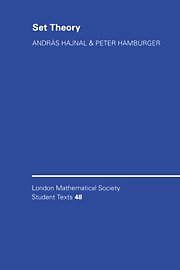Book contents
- Frontmatter
- Contents
- Preface
- Part I Introduction to set theory
- Introduction
- 1 Notation, conventions
- 2 Definition of equivalence. The concept of cardinality. The Axiom of Choice
- 3 Countable cardinal, continuum cardinal
- 4 Comparison of cardinals
- 5 Operations with sets and cardinals
- 6 Examples
- 7 Ordered Sets. Order Types. Ordinals
- 8 Properties of wellordered sets. Good sets. The ordinal operation
- 9 Transfinite induction and recursion. Some consequences of the Axiom of Choice, the Wellordering Theorem
- 10 Definition of the cardinality operation. Properties of cardinalities. The cofinality operation
- 11 Properties of the power operation
- Hints for solving problems marked with * in Part I
- Appendix. An axiomatic development of set theory
- Part II Topics in combinatorial set theory
- Bibliography
- List of symbols
- Name index
- Subject index
Introduction
Published online by Cambridge University Press: 10 May 2010
- Frontmatter
- Contents
- Preface
- Part I Introduction to set theory
- Introduction
- 1 Notation, conventions
- 2 Definition of equivalence. The concept of cardinality. The Axiom of Choice
- 3 Countable cardinal, continuum cardinal
- 4 Comparison of cardinals
- 5 Operations with sets and cardinals
- 6 Examples
- 7 Ordered Sets. Order Types. Ordinals
- 8 Properties of wellordered sets. Good sets. The ordinal operation
- 9 Transfinite induction and recursion. Some consequences of the Axiom of Choice, the Wellordering Theorem
- 10 Definition of the cardinality operation. Properties of cardinalities. The cofinality operation
- 11 Properties of the power operation
- Hints for solving problems marked with * in Part I
- Appendix. An axiomatic development of set theory
- Part II Topics in combinatorial set theory
- Bibliography
- List of symbols
- Name index
- Subject index
Summary
In creating set theory, Cantor primarily studied sets occurring in mathematics, such as sets of the integers and the real numbers and their subsets. The reader with a certain grasp of mathematics has an intuitive picture of these. If we want to study sets in general, we have to clarify, when we consider a set as given, what kind of sets exist. In the initial, “romantic” period of set theory, this problem did not arise. Every “conceivable” set was thought to exist, every collection for which it was possible to say in some way what its elements were was considered a set. It soon turned out, however, that this viewpoint is untenable, since, as we will see, the set of all elements cannot possibly exist. This turn of events eventually led to the development of axiomatic set theory. The usual axiomatic approach postulates only the existence of a single set, and other sets can be obtained from this set with the aid of the so-called conditional set existence axioms. In order to develop set theory along these lines, a number of theorems are needed which would be of no interest to the reader getting acquainted with the subject for the first time if no examples for their applications could be provided. This was one of the considerations that led us to present a half-intuitive, and half-axiomatic development of the subject.
In what follows, we consider a few sets commonly used in mathematics, such as the set of integers, of the rationals, and of the reals. Beyond these, we only consider sets whose existence can be derived from the conventions enumerated below.
- Type
- Chapter
- Information
- Set Theory , pp. 3 - 4Publisher: Cambridge University PressPrint publication year: 1999

